August 6, 2018 / admin / 0 Comments
Before I get going with this article, let me just clarify who the target audience is for this default/freeware aircraft in P3D v4 article. I’m NOT writing this article for the seasoned, hard-core flight sim enthusiast who most likely will read the title of this piece and even without reading the article immediately pass judgement on the author and/or on others who may actually benefit from the information it contains. I’m writing this piece for those who don’t buy into the hype that only sophisticated, complex, study-level, payware aircraft is the end all, be all in our hobby. Not every individual who is new to our wonderful hobby can immediately afford to drop money for whatever sim platform they have chosen, then turn around and drop even more money on payware aircraft.
Once upon a time…
Once upon a time all we had available to us were default aircraft. I spent dozens, hundreds of hours back in the early 1980’s flying around Meig’s Field on my Commodore 64 in a Cessna. It’s all we had and we made do. I vaguely remember at some point subLOGIC released additional scenery disks which included more airports and larger regions to explore. As I moved from the C-64 to a PC in the early 90’s things began to change. But change really didn’t start happening until the dawn of the internet age and around the time of Flight Simulator 95 (1996), Flight Simulator 98 (1997) and then Flight Simulator 2000 (late 1999).
Actually, I believe it was the release of Flight Simulator 2000 which we owe the biggest amount of gratitude for as it was this particular release which brought about the largest amount of improvements and helped to launch the online network SATCO, which eventually became VATSIM in 2001. It was also FS2000 which brought us the Concorde and the Boeing 777 as default aircraft.
Freeware is Cool
Freeware began making the flight sim scene through early websites created by Avsim and Flightsim.com. Even online networks like CompuServe offered the ability to upload/download and share various freeware add-ons. My earliest memories of good, quality freeware aircraft was from a group called Project OpenSky or POSKY for short. I believe of all things (not including Microsoft Flight Simulator) that could be singled out as the #1 draw of bringing more enthusiasts into the flight sim community, it would be POSKY. POSKY had the very best freeware models available anywhere. You wanted to fly a Boeing 727, 737, 747, 757 etc. POSKY had it and the community supported them. Some of my fondest and earliest memories of flying on the VATSIM network in the early days were flying POSKY aircraft.
Birth of Payware
I honestly can’t remember when I first began to see payware aircraft hitting the market. I can tell you the first payware aircraft I ever purchased was the Level-D 767 and I absolutely loved it. I would take a wild guess and say it was around 2002/03 timeframe. Next was the iFly 737 NGX as it was released before PMDG released their NGX and honestly the rest were purchased as they became available.
Payware kill the freeware star?
Just a little play on words there and another musical reference. The more you read my articles the more you’ll see small references to my favorite decade of music. But in all seriousness, there was a period of time where both the freeware and payware markets were healthy, vibrant and lived together in harmony. But at some stage the unfortunate thing began to happen. As payware aircraft began to gain in popularity, the decline of good, quality freeware (and those who were developing it) also began the slow decline. Today, it’s difficult to find descent looking and performing freeware aircraft for Prepar3D (especially v4). But I’ll share a website with you shortly that may be changing all this.
The Advancement of Default Aircraft
If you look back at the different versions of Microsoft Flight Simulator, each new release offered something new. The earlier versions all focused around single engine aircraft. Today I view this as all part of my overall sim-based learning as one must crawl before we can walk. I think it was sometime in the very early 90’s before the 747 appeared as a default aircraft in MSFS. One thing I remember about the MSFS default aircraft is they always performed really well. Some of the POSKY aircraft I mentioned earlier was more or less based on the default aircraft and performed equally as well.
But if you’re a fan of the tubeliner, and you’ve just purchased Prepar3D…you’ll be disappointed as you won’t find a Boeing 737, 747, 757 etc. in the fleet of default aircraft. But of course, there’s an important reason for this…as P3D isn’t licensed for entertainment purposes even though I firmly believe the majority of licensed users fall directly into that category. But let’s not go down that rat hole.
Freeware Still Lives Here
As I mentioned at the top of this article, not everyone can afford to shell out the cost of the new sim (P3D v4), then rush out to purchase their favorite Boeing or Airbus airliner. While I’m of the opinion that most payware (even study level category) is far superior in performance and provide a higher level of immersion and overall enjoyment than freeware, I must admit that I’m impressed with the selection of freeware aircraft available from Rikoooo.com. I’m not really sure how long this site has been operational, but I see more and more folks posting screenshots on Facebook from some of the freeware aircraft options available. There’s even a pretty descent Airbus A380 which I’ve installed and spent a little time playing around with.
No Time for Study
As I was writing this article, I saw a Facebook comment posted in one of the flight sim groups I follow. The individual posting mentioned the fact that he really didn’t have time to study, the study level aircraft. He didn’t want to spend the necessary time to flip switches, program a complex FMS. He wanted to basically fly and that’s how he defined his level of enjoyment. I take my hat off to this individual for recognizing what he wants from his time in the sim. But if did get me thinking and I’ll share my thoughts next week. I also plan to document/create a short series of tutorials breaking down how I learn and fly the more complex, study level, payware aircraft. After all, if I can do this….anyone can do this.
Final Thoughts
I’ve already started drafting the frame work for next weeks article. I think the title will be something like “The Joy of Study Level Aircraft” (or something like that). It’s shaping up to kick start a short series of tutorial articles on the processes I go through when flying these types of aircraft. Yes, you’ll need to devote a bit more time….as one does need to do a little switch flipping and FMS programming, but I believe the satisfaction is much greater in the long run and I’ll explain why I believe this as well. But between now and then, let me leave you with something most of my YouTube viewers will have heard me say more than once in my videos.
There’s no right or wrong way to enjoy a simulation based game. Only each individual (YOU) can determine what they want from the time they spend playing. If a default or freeware aircraft model does that…then you’ve checked all the boxes and don’t let anyone tell you different.
Until next time…
Enjoy Flight on YOUR TERMS!
Jerry
August 4, 2018 / admin / 0 Comments
While I’m certainly hopeful you are enjoying this tour and learning a few things along the way, I’m certainly enjoying flying and documenting it all for you. Of all my years enjoying the flight simulation hobby, this tour as found me flying more in Africa than I believe I’ve ever done before. I’ll also be honest and say that other than Ethiopian Airlines and South African Airways, most of the others I had never heard of until I began planning this tour. For this leg, (our final leg in Africa) we will be flying the PMDG Boeing 737-800 in the Royal Air Maroc livery. You can learn more about this airline below.
While we’re making great progress, we still haven’t passed the half-way mark of our journey. But as previously stated, this will be the final leg within the African continent. Leg 17 will have us flying northwest to the small island of Madeira where our travelers will spend several days exploring the island and relaxing on the beach. Madeira is one of Portugal’s main tourist destinations.
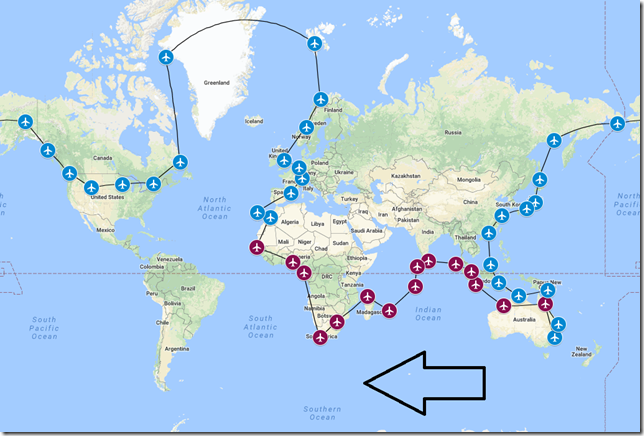
History of City
Agadir is a major city in mid-southern Morocco and is located on the shore of the Atlantic Ocean and near the foot of the Atlas Mountains. It is 508 km south of Casablanca and is one of the major urban centers of Morocco. The mild winter climate and good beaches have made it a major “winter sun” destination for northern Europeans.
History of Country
Morocco is a unitary sovereign state located in Northwest Africa. It is one of the native homelands of the indigenous Berber people. Geographically, Morocco is characterized by a rugged mountainous interior, large tracts of desert and a lengthy coastline along the Atlantic Ocean and Mediterranean Sea.
History of Airport
The Agadir – Al Massira Airport (GMAD) is located in Temsia, 20km from Agadir proper. In 2007, the airport served over 1.5 million passengers and is a popular destination served by many European destinations.
History of Airline
Royal Air Maroc was founded in 1957 and is fully owned by the government of Morocco. The airline operates a domestic network throughout Morocco and scheduled flights to Africa, Asia, Europe and North and South America.
Flight Briefing
RAM1066
GOBD – GMAD
Planned Fuel – 19,000 lbs
Planned Altitude – 39,000
Distance – 1035nm
Flight Time – 2hrs, 45min
Route: YF UR975 ARSOL ARSO2A

Flight Journal
For the most part, our tour has been uneventful. I think everyone agrees the weather could have been a little more cooperative. But hey, you just have to roll with the punches and make the very best out of everything life offers. Said in another way, when life gives you lemons….make lemonade! Our travelers have been doing just that by taking everything into stride. After all, this truly is a chance of a lifetime for many.
The itinerary for the past few stops in Africa has been rather quick, but still packed full of action and adventure. But I can tell the constant Go, Go, Go is starting to take its toll on many. Not to worry…once we reach the island of Madeira, the pace of travel will slow down a bit and our travelers will have several days to just soak up the sun and enjoy themselves. This will also be nice for myself and my crew. But first, we must load up once again for the 16th leg of our journey and fly the group to Morocco.
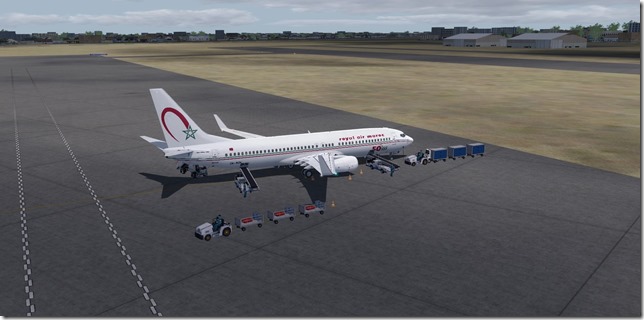
Our travelers have arrived by bus and will soon board the aircraft.
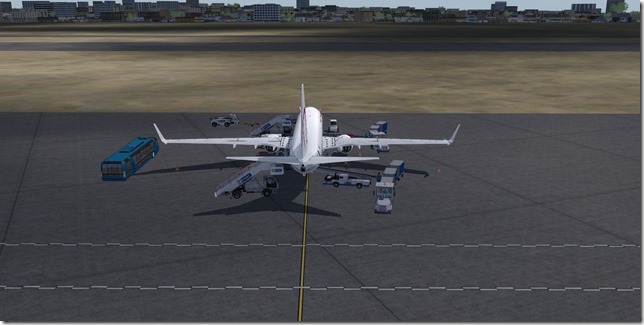
All have boarded and we’re ready for pushback.
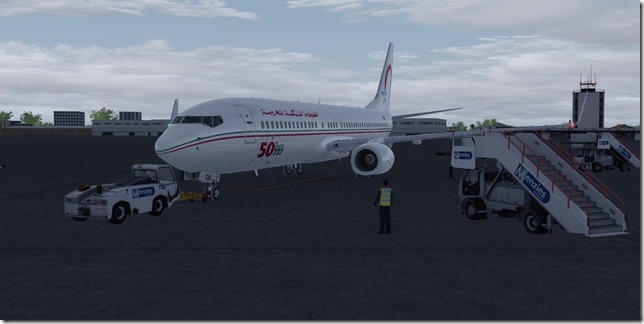
A short taxi out to the active runway in our Royal Air Maroc Boeing 737-800.
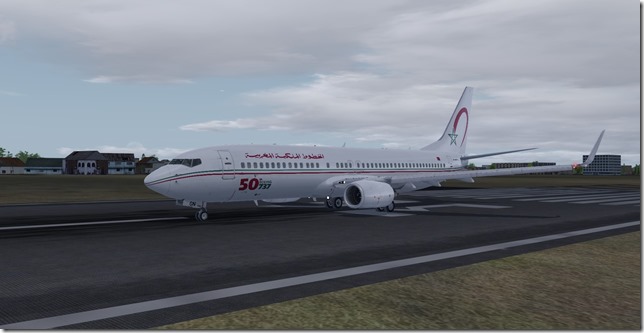
Once again, we’re up, up and away….

Climbing out on our departure SID.
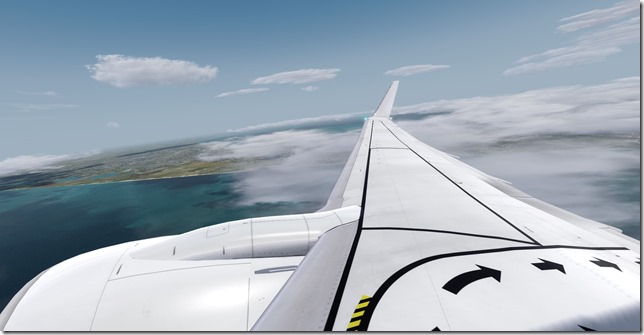
The Royal Air Maroc 50th Boeing 737 livery.
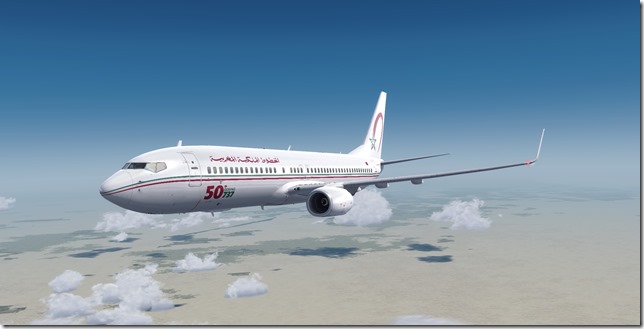
We’ve witnessed many different types of terrain on our journey. The sand dunes of the Sahara below.
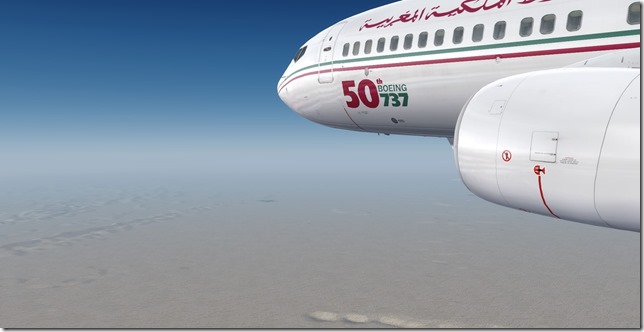
More dunes
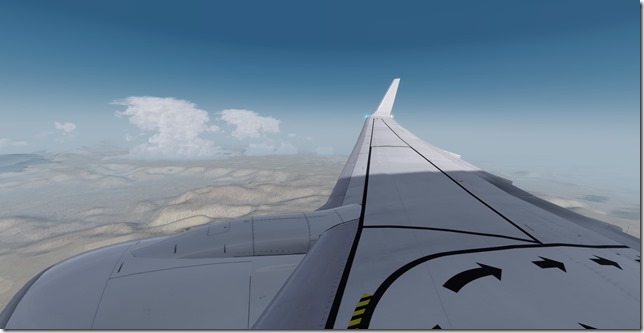
Thunderstorms in the area delayed our approach as ATC vectored us around the strong cells.
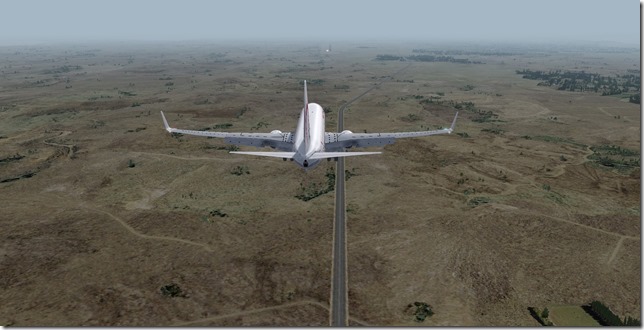
Runway insight and we’ll be landing soon.
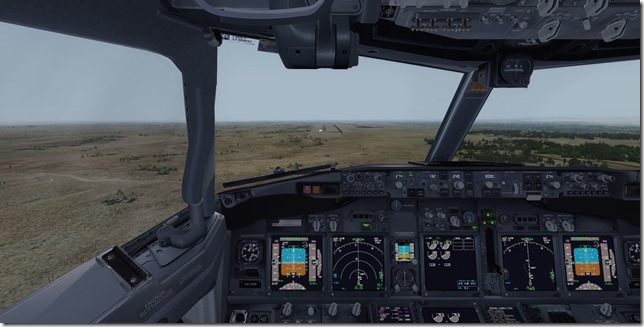
On the ground in Morocco. Our travelers will deboard soon and be taken to the airport customs facility.
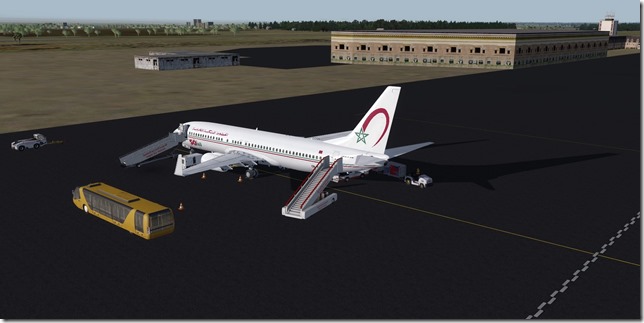
Once again, our stay in Morocco will be short. In just a little under 36 hours, we’ll depart Morocco for the tiny island of Madeira. For myself and the flight crew, the approach into Madeira will be one of the most difficult of the journey. More more about that next time.
Until next time…Thank you for reading!
Jerry
August 1, 2018 / admin / 2 Comments
POSCON – Positive Control Network Will Be Awesome! Yep, you heard it here first….
But let me be brutally honest. When I first learned of a planned new online flight sim multiplayer network I sort of rolled my eyes and pondered WHY? Unless you’re new to my blog postings, then you know I’ve been flying computer based sims since the 1980’s and have been a part of the flight sim community since the dawn of the Internet age and have been blogging about this hobby for well over 10 years. I’ve also been an active member of the VATSIM network since the day it was founded back in 2001. Yea…I’m nearly old as dirt, I have opinions…but I absolutely love this hobby. Much of the reason I asked “WHY” was down to the fact that I figured a third online multiplayer network would just further dilute IVAO/VATSIM, which in turn would just make all three mostly a wasteland of virtual air space. After all, contrary to popular belief, the flight sim community is rather small in comparison to other gaming communities.
What is POSCON?
POSCON or Positive Control Network is the next generation flight simulation network. The team behind POSCON are a mix of aviation professionals, hobbyists and enthusiasts who have experienced the need for an improved, modern flight sim network that supports the latest and greatest technologies.
But Why Something New?
As I previously mentioned, I too asked myself why. After all, not all change is good. Yes, I’m fully aware that both IVAO and VATSIM have their issues. While I’ve flown on both networks in the past, VATSIM is my primary network of choice and while much of their infrastructure is seriously outdated (especially their voice codec) my initial thoughts were let’s focus on fixing what we already have, before we head down the path of something new. After all, both IVAO and VATSIM were born as a result of management differences with the old SATCO network which was developed in the late 1990’s.
POSCON Is Not Just Something New
That’s right! From the outside, yea….sure….POSCON will be a new online flight sim multiplayer network. But, once you begin to peel back the layers, you’ll soon learn that POSCON is not just something new. Instead, POSCON is something DIFFERENT! Very, very, very different from what we have now.
POSCON Will Be Immersive
A total immersive experience is the absolute goal behind POSCON. The immersion factor begins well before you get into the flight deck and will end well after you’ve landed and parked at your gate/stand.
POSCON will not be just a casual flying network. Today in the VATSIM/IVAO environment, the immersion ends immediately after the flight. POSCON will include additional features to reward virtual pilots who want to achieve full immersion before, during and after each flight. POSCON will include a system behind every thing that is done on the network. The additional immersion features will ensure there’s more to your flight than just landing after diverting to another airport and logging off the network. Pilots will be rewarded for making the extra effort to submit a logbook entry just as it’s done in the real world.
POSCON Events
POSCON events will be different from what we have experienced with VATSIM/IVAO. Events will no longer be just a point A to point B only experience. Air traffic during events will depart from multiple airports within a region to other multiple airports in another regions. The overall experience during events will better simulate real world air traffic with flights arriving into large international airports, smaller regional airports and overhead cross traffic. In other words, the experience is not just about trying to land 500 planes into one airport.
AI Traffic
Don’t always have time to fly during events or when most users are logged in? Neither do I and sometimes it does get a bit lonely being the only aircraft landing/departing from our favorite airports. If flying offline, most AI Traffic packages don’t always simulate real-world operations. It bugs me to no end when I see AI aircraft landing on runways which I know are not used in the real world.
POSCON will fill the virtual skies with interactive AI. Quoted directly from the POSCON website “Imagine for a minute a network without any traffic dead zones. For pilots, this means a flight that never gets boring. For ATC, this means you can sign on at 9 AM and still work a busy sector. Our algorithms will generate traffic based on real world airline flight schedules and inject them into the live network. Controllers have the option of tracking these targets and, when they do, the AI drones will come onto the frequency and be controllable through voice. As live traffic on the network increases, the untracked AI traffic will begin to drop offline to allow for a manageable level of traffic for controllers.” Pretty cool, huh? I thought so too!
Real World Scenarios
Yea…I’m guilty of seeking out the worst weather imaginable. Whether it be a massive snow storm or hurricane force winds/rain I’m often loading up my sim, logging onto VATSIM and thinking YOLO (You Only Live Once) and flying my PMDG 737. But in the real world, airlines and pilots would never do this. POSCON may close airports in these types of scenarios and offer pilots one of two choices. Option one…divert! Option two…hold! I think that’s cool and that my friends is total immersion!
Air Traffic Controllers will also have access to real world weather conditions right in their POSCON controller client and will be able to vector traffic around strong storm cells just like real world operations.
POSCON Data Link
POSCON data link features for enhanced commercial flying will be a feature. Example, You’re flying an American Airlines 738 into Denver. You’ll receive a message via the POSCON Data Link providing you the gate assignment on arrival. The ATC controller client will also receive this same information. In the event someone spawns in and occupies that same gate, then POSCON will attempt to provide a gate change assignment. However, as is the case in the real world (flown into Heathrow lately?), pilots may experience a ground hold until gate assignment becomes available. POSCON will reward pilots for their patience and/or effort in helping to keep the immersion to a high standard. These rewards will be part of the POSCON pilot record.
In addition, communications for large events like Cross the Pond would be handled most via data link messages just as they are in the real world. At any given point in time, hundreds of aircraft are flying across the Atlantic…but very little verbal audio communications take place. It’s all done via data link messages.
POSCON Audio Quality & Communications
POSCON audio is custom and will be as clear as real world communications and at times may be as distorted as real world communications can be. Modulation simulation, HF/VHF simulation will all be simulated into the system. POSCON will also offer a voice Unicom and will be managed via the AI system and will monitor pilot behavior. The system will have the ability to take a snapshot of the pilot behavior for review by supervisors.
POSCON will not have the ability for free form text messages, but instead will include predefined messages that can be sent to the controller. While ATC in the real world is English only, POSCON will have the ability for non English language support. All predefined messages will be translated into multiple languages. A Chinese virtual pilot could send a message that he/she would view in Chinese, but other pilots/controllers would see that message in their native language or English.
What About Model Matching
One of the major bugbears with VATSIM and IVAO is model matching. Simply put, model matching means if I’m flying online and another aircraft is nearby, I want to see that other aircraft depicted in the exact type of aircraft AND livery as it should be. POSCON plans a very unique method of handling model matching where multiplayer traffic will be stored on the cloud and dynamically downloaded and injected as the user navigates online. Only the models which are needed will be downloaded, displayed and deleted as necessary. Very Cool!
What Else Can I Tell You?
POSCON is expected to be released sometime mid 2019 with early access beta possible in very early 2019. The plan is for an open beta as the POSCON Dev Team wants 100% transparency. So any and all who would like to participate will be able to participate.
You might be asking yourself, gosh Jerry this all sounds absolutely amazing…but how much will all this cost me? Great question and the answer to that question is NOTHING! POSCON will be 100% and absolutely FREE!
Final Thoughts
I doubt these will truly be my final thoughts on this subject. But for this posting and at this time, I’ve just got to say that if POSCON becomes reality…then this will truly be a thing of beauty. Of course, many are saying that POSCON will kill VATSIM and IVAO. I don’t think so. I think POSCON may prove not to be for everyone and in this case, those virtual pilots will continue to enjoy VATSIM/IVAO just as they do today.
But as I’ve said many times before, the changes I’ve seen in the flight sim hobby over the past 35+ years have truly been amazing. Whether it be the features of ground handling services of GSX (when working properly), the injection of real world weather from ActiveSky, the icing effects and bug splatter on the FSLabs A319 and hopefully all the goodness I’ve just been blabbering about from POSCON. When I think back to what things were like in the early 1980’s on my Commodore 64 to what they are now…God it’s truly a great time to be alive.
Want to learn more? Yes, I’ve covered a lot and I think I’ve just about covered everything publically available today with regards to POSCON, but should you want to know more or just want to check out the POSCON website, then please do so. I’ll certainly provide more details as it becomes available and I truly look forward to the open beta and the general release of what is shaping up to be a very cool addition to our already amazing hobby.
Until next time…
Happy Flying!!!
Jerry
August 1, 2018 / admin / 0 Comments
As we begin our flight for the 15th leg of our 46 leg journey, we’ll be achieving something we’ve yet to do in the over 13,000 miles we’ve traveled since leaving Sydney just over two months ago. This leg will place us further north (in the northern hemisphere) than we’ve previously traveled and the next ten legs will all have us traveling in a northerly direction as we continue to explore northwestern Africa, Europe, United Kingdom and Scandinavia.
That’s right! We started our little journey (little, who am I kidding?) back on 2 June when we departed a rainy/cloudy Sydney, Australia. Rain and clouds have pretty much been the general theme of this tour. But this is just the luck of the draw really. I’m using a flight sim add-on called ActiveSky which adds real-world weather into the sim and as it happens, each location where I’ve been flying (at the time I’m completing the flights) has been mostly rain and cloudy conditions. This may improve as very soon we’ll be entering Europe which has been experiencing unseasonably hot and dry conditions the past few weeks. But enough about all this….let’s get started with this leg of the journey.
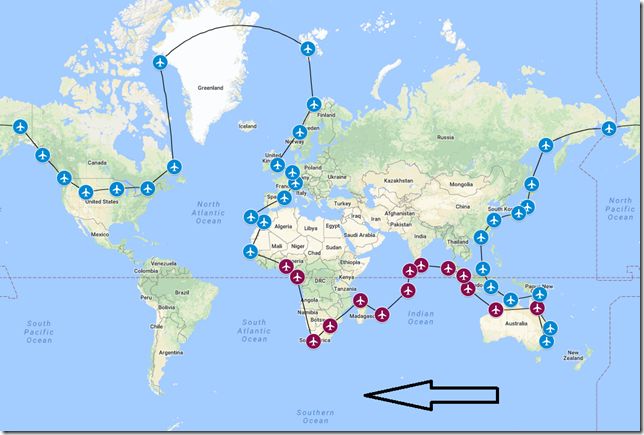
History of City
Ndiass (or Diass) is a village and rural community in the M’bour Department in the Thies Region of Senegal. It is located 40 km southeast of Dakar. Diass has a population of 4,794.
History of Country
Senegal is a country in West Africa and is bordered with Mauritania in the north, Mali to the east and Guinea to the Southeast. The name Senegal means “Our Boat”. Senegal covers a land area of almost 76,000 square miles and has an estimated population of about 15 million.
History of Airport
The Blaise Diagne International Airport near the town of Diass, Senegal. It’s the primary airport serving the capital city of Dakar. The airport was originally scheduled to open towards the end of 2011, but didn’t open for service until December 7, 2017.
History of Airline
Arik Air is a Nigerian airline which began operations in 2006. They have a small, but growing fleet of 14 aircraft. Arik Air has built up a domestic network covering mainly Nigerian and several other Western African destinations.
Flight Briefing
ARA1066
DNMM – GOBD
Planned Fuel – 24,000 lbs
Planned Altitude – 36,000
Distance – 1319nm
Flight Time: 3hr, 30min
Route: POLT1Q POLTO UL433 TYE UA601 YF
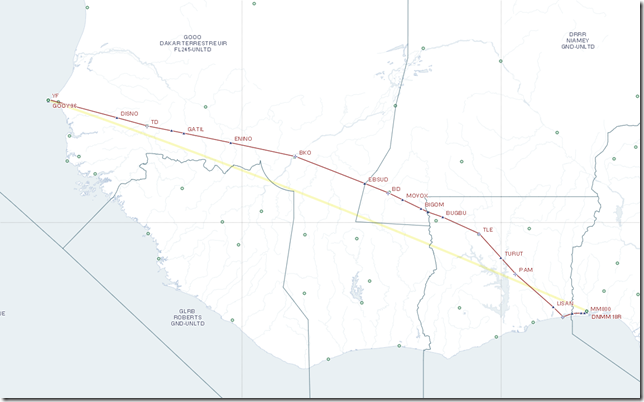
Flight Journal
Our travelers are still talking about the awesome experience they had down in Cape Town with the breaching Great White Sharks, but are equally excited about what all else lies in store for them as our journey continues around the world. Due to the weather conditions, we didn’t have a lot of time for photos on the ground so we loaded up in our Arik Air Boeing 737-800 and taxied out to the active runway for departure.
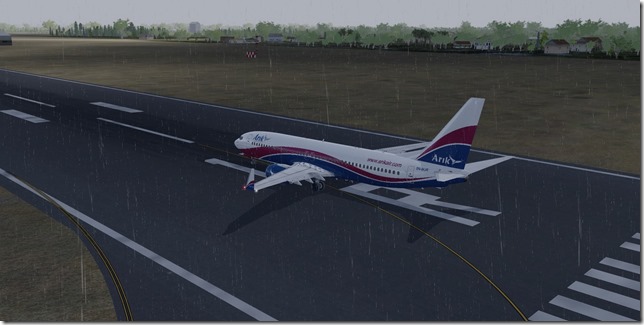
Positive Rate, Gear Up!
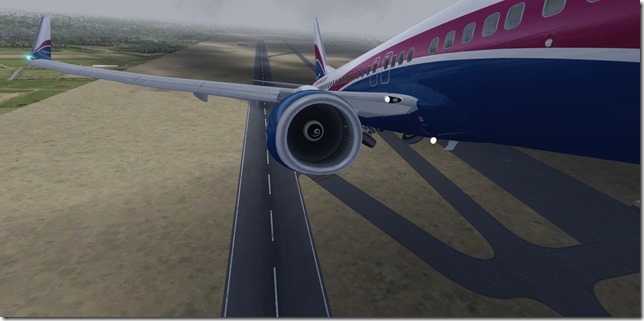
A bit of light chop as we climb out.
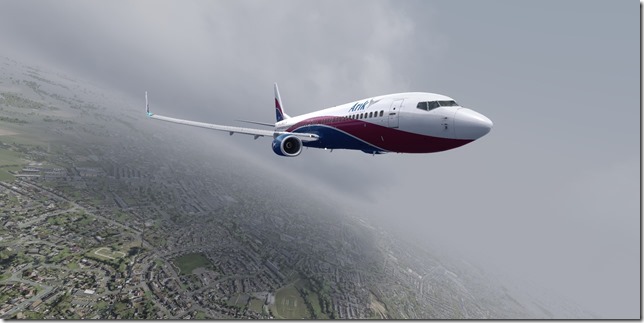
We’ll soon be above the clouds.

The African coastline is beautiful.

Last look at the coastline for a few hours.
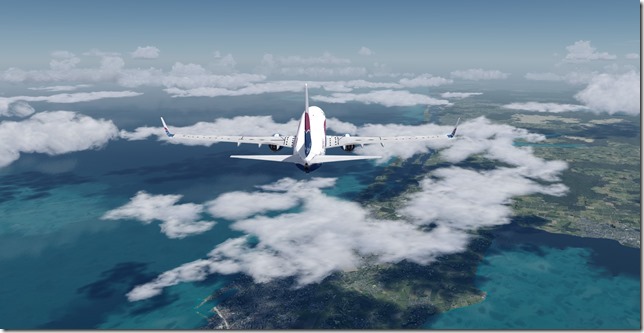
The Moon as we cruise at flight level 360.

The terrain is slowly changing.
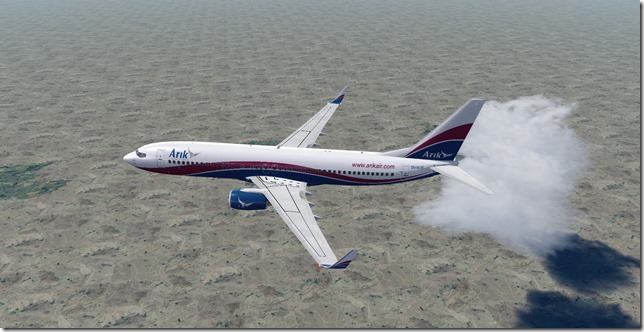
And then changing back as we near the coastline again.
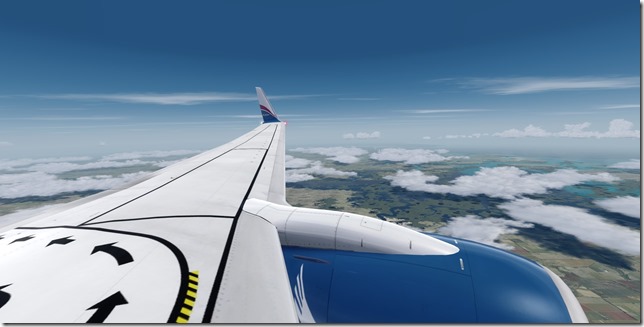
The beautiful lush farm land as we descend below 10,000 feet.
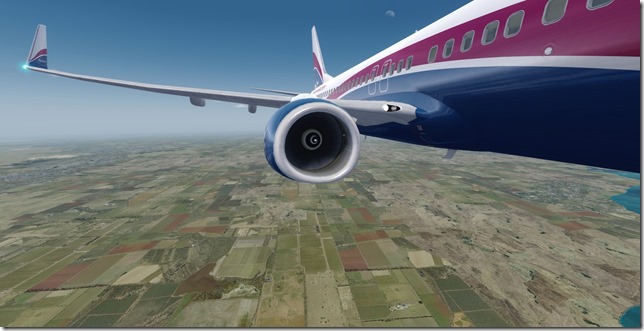
Another strong cross-wind landing.
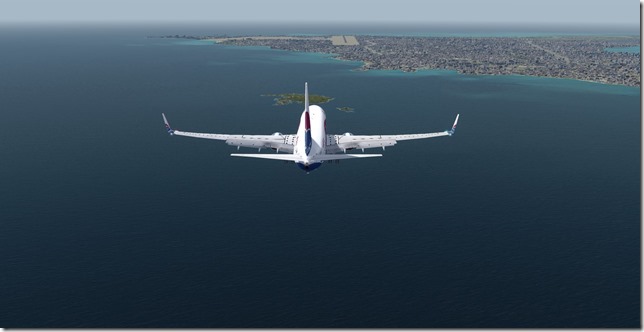
Our fully configured Boeing 738, cleared to land.

The wing view on final approach.
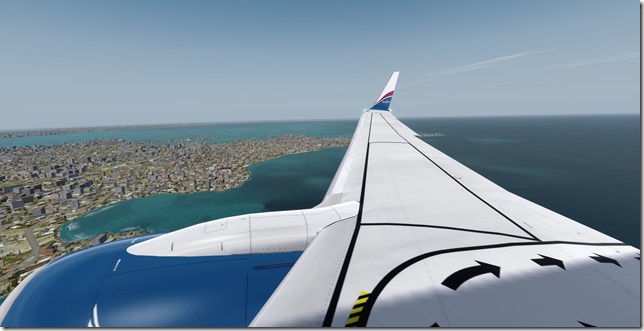
Fighting the strong crosswind. But we have no choice as there are no other runway options.

Safely on the ground, parked and unloading.

Simulator Specifics
Prepar3d v4.3
ActiveSky Weather Engine
ActiveSky Cloud Art
Envtex & Envshade
PMDG 737-800 (Arik Air livery)
Orbx Global Texture
VATSIM
Route Planning Tools
AivlaSoft PFPX
Navigraph Charts Desktop
FlightAware
FlightRadar24
SkyVector
Google Maps
Computer Hardware Specs
Our travelers will only stay two days in Senegal before departing for Morocco. Our next flight will once again be in the Boeing 737-800 as we ferry a Royal Air Maroc B738 to Morocco.
Until next time…Happy Flying!
Jerry































